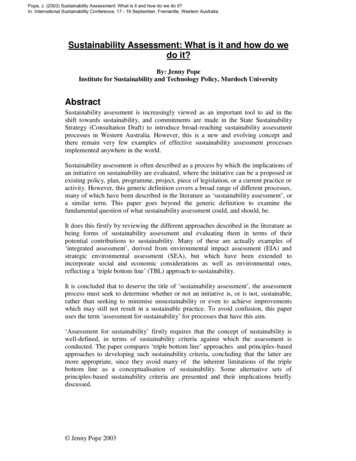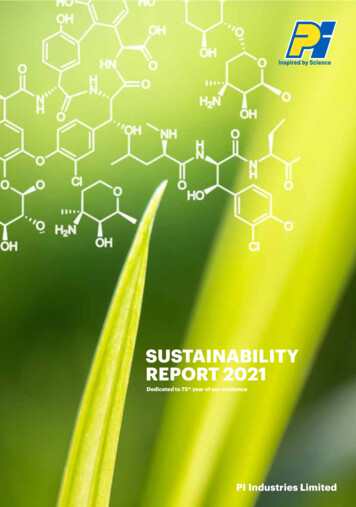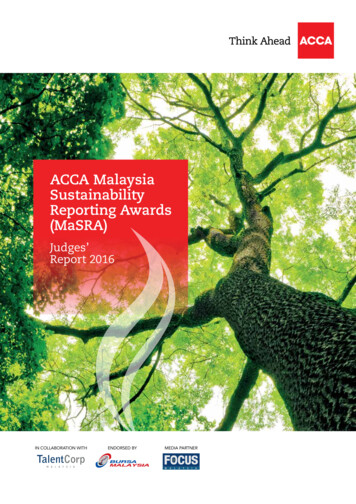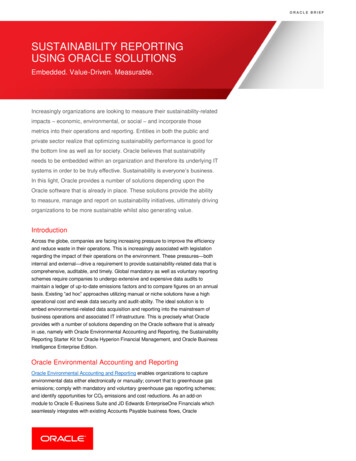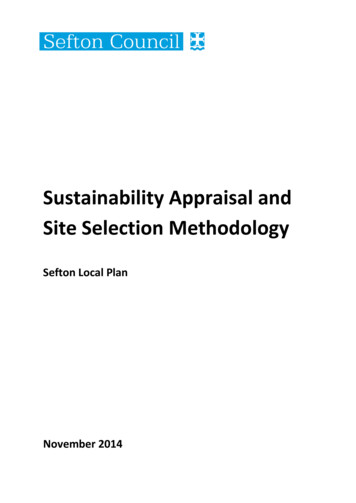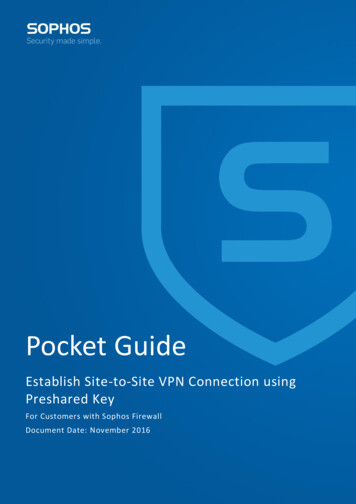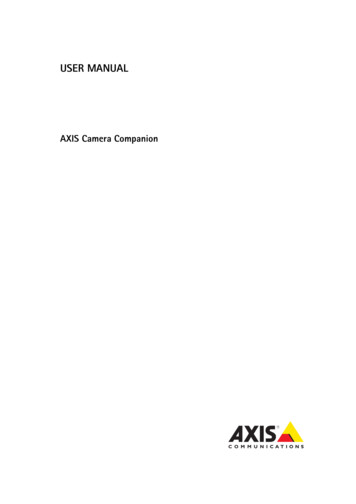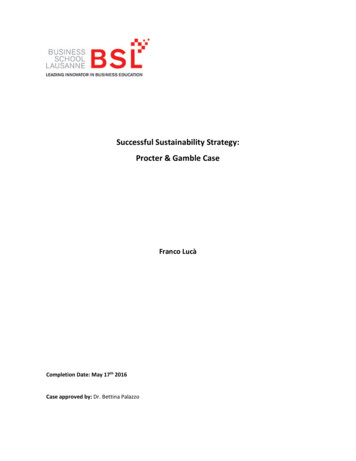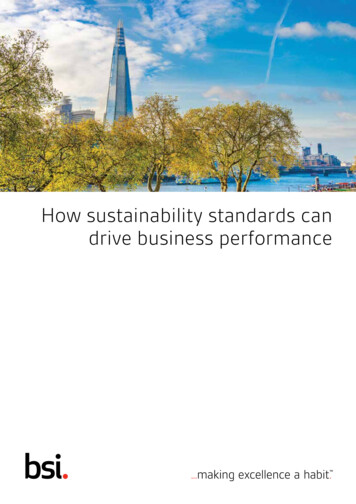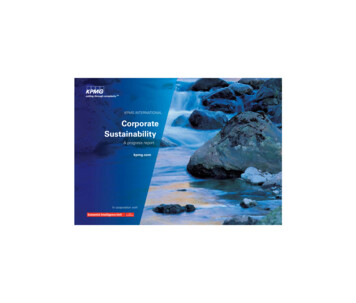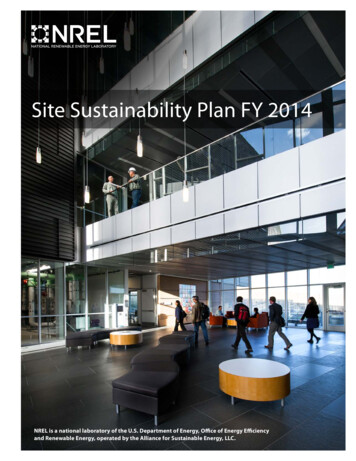
Transcription
Site Sustainability Plan FY 2014NREL is a national laboratory of the U.S. Department of Energy, Office of Energy Efficiencyand Renewable Energy, operated by the Alliance for Sustainable Energy, LLC.
The National Wind Technology Center has 10.2 MW ofon-site wind systems.Site Sustainability Plan 2014Table of ContentsNOMENCLATURE. IIEXECUTIVE SUMMARY. 1GREENHOUSE GAS REDUCTION. 7BUILDINGS, ESPC, REGIONAL AND LOCAL PLANNING.13HIGH PERFORMANCE SUSTAINABLE BUILDINGS.13ENERGY.17REGIONAL AND LOCAL PLANNING.20FLEET MANAGEMENT.23WATER EFFICIENCY AND MANAGEMENT.26POLLUTION PREVENTION AND WASTE REDUCTION.29SUSTAINABLE ACQUISITION.33DATA CENTERS AND ELECTRONIC STEWARDSHIP.35RENEWABLE ENERGY.38CLIMATE CHANGE ADAPTATION.40Cover photo: The new LEED Platinum Energy Systems IntegrationFacility is the first U.S. facility in which both the public andprivate sector researchers can scale-up clean energy technologies.
NOMENCLATUREAFUF – Alternative Fuel User FacilityAFV – Alternative Fuel VehiclesASHRAE – American Society of Heating, Refrigerating, andAir-Conditioning EngineersAWS – Alternative Work SchedulesBA – Building AgentBBTU – Billion British Thermal UnitsBTU – British Thermal UnitsCD – Construction DocumentCEDR – Consolidated Energy Data ReportCLI – Congressional Line ItemCNG – Compressed Natural GasCRADA – Cooperative Research and Development AgreementCU – University of ColoradoDOE – Department of EnergyDOE-GFO – Department of Energy Golden Field OfficeE85 – Ethanol 85EA – Environmental AssessmentECM – Energy Conservation MeasureEERE – Office of Energy Efficiency and Renewable EnergyeGRID – Emissions and Generation Resource Integrated DatabaseEISA – Energy Independence and Security Act of 2007EMS – Environmental Management SystemEO – Executive OrderEPA – Environmental Protection AgencyEPEAT – Electronic Product Environmental Assessment ToolEPP – Environmentally Preferable PurchasingESCO – Energy Services CompanyESIF – Energy Systems Integration FacilityESPC – Energy Savings Performance ContractFAA – Federal Aviation AdministrationFAST – Federal Automotive Statistical ToolFEC – Federal Electronics ChallengeFEMP – Federal Energy Management ProgramFGC – Federal Green ChallengeFIMS – Facilities Information Management SystemFTC – Federal Trade CommissionFTLB – Field Test Laboratory Buildingft2 – Square FeetFY – Fiscal YearGGE – Gallons of Gas EquivalentGHG – Greenhouse GasGP – Guiding Principles for High Performance Sustainable BuildingsGSA – General Services AdministrationGSF – Gross Square FeetHPC – High Performance ComputerHPSB – High Performance Sustainable BuildingsHVAC – Heating, Ventilation, and Air ConditioningIBRF – Integrated Biorefinery Research FacilityIES – Integrated Environmental StrategiesILA – Industrial, Landscaping, and AgriculturaliiSITE SUSTA INA BILIT Y PL A N 2014 nomenclatur eIPCC – Intergovernmental Panel on Climate ChangeISMS – Integrated Safety Management SystemISO – International Organization for StandardizationIT – Information TechnologykBTU – Thousand British Thermal UnitskW – KilowattkWh – Kilowatt-hourLEED – Leadership in Energy and Environmental DesignLEED EB-O&M – LEED Existing Buildings: Operations and MaintenanceLID – Low Impact DevelopmentMFD – Multifunction DevicesMMBTU – Million British Thermal UnitsMTCO2e – Metric Ton Carbon Dioxide EquivalentMW – MegawattMWh – Megawatt-hourNEPA – National Environmental Policy ActNREL – National Renewable Energy LaboratoryNWTC – National Wind Technology CenterOCIO – Office of the Chief Information OfficerOTF – Outdoor Test FacilityPCards – Purchase CardsPEV – Plug-in Electric VehiclePPA – Power Purchase AgreementPUE – Power Usage EffectivenessPV – PhotovoltaicsREC – Renewable Energy CertificateReFUEL – Renewable Fuels and LubricantsRFHP – Renewable Fuel Heat PlantRFID – Radio Frequency IdentificationRSF – Research Support FacilityRTD – Regional Transportation DistrictSERF – Solar Energy Research FacilityS&R – Shipping and ReceivingSF6 – Sulfur HexafluorideSITES – Sustainable Sites InitiativeSPO – Sustainability Performance OfficeSRRL – Solar Radiation Research LaboratorySSEB – South Site Entrance BuildingSSPP – Strategic Sustainability Performance PlanS&R – Shipping & ReceivingS&TF – Science and Technology FacilitySTM – South Table MountainSustainable NREL – NREL’s Sustainability ProgramT&D – Transmission and DistributionTTF – Thermal Test FacilityUSGBC – United States Green Building CouncilUV – Ultraviolet LightVOC – Volatile Organic CompoundsWestern – Western Area Power AdministrationWM – Waste Management
EXECUTIVE SUMMARYNREL Senior Scientists Ross Larsen and Travis Kemper examinea molecular model of Plymeric organic nitroxide radical (PTMA)film for battery applications using a 3D model at the InsightCollaboration Laboratory.SITE MANAGEMENT VISION . . . . . . . . . . . . . . . . . . . . .The Department of Energy’s (DOE) National Renewable EnergyLaboratory’s (NREL) goal is to expand our leadership as astate-of-the-art laboratory that supports innovative research,development, and commercialization of renewable energyand energy efficiency technologies that address the nation’senergy and environmental needs. Fundamental to this goal isNREL’s commitment to sustainability—operating in a mannerthat balances environmental, economic, and social values inthe delivery of our mission. At NREL, sustainability is integralto both our research and operations. NREL is committed todemonstrating federal leadership in sustainability, working tocontinuously improve our performance, and lead by example.NREL’s Sustainability Program, Sustainable NREL, is a longstanding laboratory program that fosters environmental andsocial responsibility and works to establish the lab as a globalmodel for sustainability. Sustainable NREL is responsible forupholding all executive orders, federal regulations, DOE orders,and goals related to sustainable facility operations. This programalso executes NREL-specific goals to reduce our impacts onthe community and environment and provides technicalexpertise to other organizations within the lab. Sustainable NRELprovides leadership within the federal government and ourcommunity by actively mentoring and collaborating with otherorganizations to establish sustainability as the new paradigm.NREL’s campus has been constructed as a living laboratorythat showcases new technologies, design practices, andoperating behaviors. In all campus development, NREL looksfor opportunities to integrate energy efficiency and renewableenergy, high-performance buildings, sustainable transportationalternatives, and sensitivity to the community and environment.On-site testing and deployment of technologies developed byNREL researchers is also emphasized.SITE SUSTA INA BILIT Y PL A N 2014 e x ecuti v e summ a ry1
MAJOR PLANNING ASSUMPTIONS, ISSUES,FUNDING STRATEGIES . . . . . . . . . . . . . . . . . . . . . . . . . . . . . . .NREL continues to experience and plan for significant campusgrowth. In FY 2013, our staff (employees and subcontractors levels)increased 4% from FY 2012, and NREL’s building square footageexpanded by 23%. While experiencing growth, in the currenteconomic climate, NREL is uncertain that this trend will continue.While there are no new Congressional Line Item (CLI) projectsidentified at this time, NREL is conducting planning activities sothat we are positioned to accommodate future growth throughthe construction of new high-performance buildings, energyefficiency retrofits, and renewable energy systems that takeadvantage of alternative financing mechanisms, including powerpurchase agreements (PPA), energy savings performance contracts(ESPC), partnerships with energy service companies (ESCO), andcooperative research agreements (CRADA). NREL continues toreview the use of overhead funds, cost savings reinvestment, andleverage alternative finance to support new projects or retrofits onour campuses.SUCCESSES AND CHALLENGES . . . . . . . . . . . . . . . . . .As market demand for renewable energy and energy efficiencycontinues to expand, NREL responds. In FY 2013, construction ofthe Energy Systems Integration Facility (ESIF) was completed andthe design for expansion of the existing Outdoor Test Facility (OTF)began. As the campus continues to grow, NREL strives to balancethe importance of our ecosystems, surrounding community, andtaxpayer dollars.At the end of FY 2013, staff from DOE’s Golden Field Office(DOE-GFO) began moving into NREL’s Research Support Facility(RSF) to reduce the need for their leased space. The additionalpopulation of roughly 260 staff may affect goal baselines as wellas NREL’s anticipated goal performance. NREL and DOE-GFO areworking together to assess these impacts and develop a strategyfor future reporting and goal achievement.Even with all new construction meeting the Guiding Principles forHigh Performance Sustainable Buildings (GP), and the additionof new on-site renewable systems, NREL’s demand for energyand water will increase. Subsequent to our population growth,greenhouse gas (GHG) emissions from purchased energy andessential business travel will continue to increase in support ofNREL’s mission. Scope 3 GHG emissions and fleet petroleum use willalso continue to be a high priority for NREL in our development ofinnovative reduction strategies.To reduce energy consumption and environmental impactsassociated with recent staff growth and the transition from off-siteleased office space to the South Table Mountain (STM) campus,NREL constructed one new high-performance sustainable buildingand achieved two Leadership in Energy & Environmental Design(LEED) Platinum certifications in FY 2013: ESIF was constructed and received LEED Platinum certification(shortly after the end of FY 2013)NREL’s Café achieved LEED Platinum certification.In FY 2013, NREL was recognized with several prestigious awardsthat acknowledged our exemplary performance in sustainability:2SITE SUSTA INA BILIT Y PL A N 2014 e x ecuti v e summ a ry Awarded three stars in Sustainable Sites Initiative (SITES) for asustainable design program for the RSF, Central Arroyo, and STMcampus pond projectsRecognized as a Best Workplace for Commuters by the NationalCenter for Urban Transportation ResearchRecognized in the Environmental Protection Agency (EPA)Federal Green Challenge both nationally and in Region 8 forgreen purchasingAchieved excellence in Sustainable Acquisitions and GreenPurchasing for the second consecutive year, attaining theGreenBuy Leadership Goal for 16 Priority ProductsReceived EPA’s Federal Electronics Challenge (FEC) PlatinumLevel Award, recognizing electronic stewardship that helpsthe federal government improve its sustainable practices inpurchasing, managing, and disposing of their electronic assets.In FY 2013, NREL also began several outreach projects to improveaccess to sustainability metrics and share information learnedthrough NREL’s sustainability efforts, including: Developing an internal dashboard to present sustainability goalperformanceCreating a SharePoint site to improve GHG data collection and aquality control process for reportingInitiating a site-specific climate change adaptation planningpilot projectDeveloping a Best Practices Guide and template materialsfor the Sustainability Performance Office’s (SPO) website forsustainability campaign development and communication forDOE sites and laboratoriesCreating webinar content to present best practices and lessonslearned on sustainable acquisitions.SUMMARY . . . . . . . . . . . . . . . . . . . . . . . . . . . . . . . . . . . . .The following table summarizes each of DOE’s StrategicSustainability Performance Plan (SSPP) goals along with NREL’sperformance status, planned actions, and an assessment of the riskof non-attainment as noted below: Technical risks. Technology is available or not available in currentfacilities and/or systems to attain the goal.Management risks. Management systems and/or policies mayrequire changes for which approval authority is outside thesustainability program or requires an internal DOE policy orprocedural change.Financial risks. Funds are/are not identified in current or out-yeartargets to achieve the goal.Each risk is assigned a rating of high (H), medium (M), low (L). High (H). Risk in at least one of the three categories is sosignificant that non-attainment of goal is likely or expected.Medium (M). Risk in at least one of the above categories is sosignificant that it is moderately likely that the goal that will notbe attained.Low (L). Any risks associated with this goal are beingsatisfactorily mitigated such that attainment of the goalis likely.
SUMMARY TABLE OF GOALS AND TARGETSSSPPGoalDOE GoalPerformance Status through FY 2013(Baseline, status, performance)Planned Actions and Contribution(Main planned actions and projected contributiontowards goals)Risk of NonattainmentHigh (H), Medium (M), Low (L)Goal 1: Greenhouse Gas Reduction and Comprehensive Greenhouse Gas Inventory1.128% Scope 1 & 2 GHGreduction by FY 2020 from aFY 2008 baselineNREL reduced Scope 1 and 2 emissions10% from the 2008 baseline without RECs and31% from the 2008 baseline (including RECs)(2013 target: 17%)Continue to operate the Renewable Fuel HeatingPlant (RFHP).Improve refrigerant and fugitive gas reportingprocesses.Purchase Renewable Energy Certificates (RECs) tooffset all Scope 2 emissions.1.213% Scope 3 GHG reductionby FY 2020 from a FY 2008baselineScope 3 emissions increased 11% from the2008 baseline(2013 target: 4%)Deploy an updated commuter survey for NREL staff.Explore feasibility of implementing improved datacollection methods for assessing ground travel andcommuting impacts.Continue to offer alternative commuting programs.Develop Scope 3 GHG reduction strategy.L – NREL has committed toimplement energy efficiencymeasures, generate on-sitepower, purchase renewablepower and RECs to offsetemissions.M – Management Risk: Tosupport NREL’s mission airtravel is necessary. Whileon a per capita basis, NRELwill meet the reductiongoal, the absolute reductionfrom the 2008 baselinewill be challenging due topopulation growth.Goal 2: Buildings, ESPC Initiative Schedule, and Regional & Local Planning2.130% energy intensity reductionby FY 2015 from a FY 2003baselineEnergy intensity has decreased over 50%since 2003Completed the Strategic Energy Management Planand pursue ISO 50001 certification for NREL’s EnergyManagement System.L – NREL will meet this goal.NREL conducted EISA evaluations for 7% oftotal site energy use in FY 2013.Perform EISA audits of three additional coveredfacilities.L - By 2015 NREL will haveassessed over 80% of the siteenergy use.(2013 target: 24%)2.2EISA Section 432 energy andwater evaluationsBenchmark buildings in Portfolio Manager andLabs21 tool as required.2.3Individual buildings meteringfor 90% of electricity (byOctober 1, 2012); for 90% ofsteam, natural gas, and chilledwater (by October 1, 2015)Replaced 13 NWTC electric submeters toincrease data quality and added 27 new metersin the ESIFContinue to develop meter – dashboardconnectivity and capabilities.L – In FY 2013 NREL is in fullcompliance.(2013 target: 90% and 50%,respectively)2.4Cool roofs, unlessuneconomical, for roofreplacements unless projectalready has CD-2 approval.New roofs must have thermalresistance of at least R-30.Cool roofs make up 69% of NREL’s roof areas, a43% increase from FY 2012.Replace Shipping & Receiving roof with new coolroof and R-30 insulation.L – NREL will continue tocomply with this requirement.2.515% of existing buildingsgreater than 5,000 gross squarefeet (GSF) are compliant withthe Guiding Principles (GPs) ofHPSB by FY 2015NREL currently has four buildings (17%)compliant with the Guiding Principles.Conduct two additional GP building assessments.L – NREL will meet or exceedthis requirement.NREL performed Guiding Principlesassessments on five additional buildingsthis year.Develop cost estimates for all assessed buildings toachieve GP compliance.(2013 target: 11%)SITE SUSTA INA BILIT Y PL A N 2014 e x ecuti v e summ a ry3
SUMMARY TABLE OF GOALS AND TARGETSSSPPGoal2.6DOE GoalAll new construction, majorrenovations, and alterations ofbuildings greater than 5,000GSF must comply with the GPs.Performance Status through FY 2013(Baseline, status, performance)Planned Actions and Contribution(Main planned actions and projected contributiontowards goals)Risk of NonattainmentHigh (H), Medium (M), Low (L)The new OTF expansion project willincorporate GP requirements into constructiondocuments.Receive LEED Platinum certification for SSEB.Alternative fuel use has grown 145% since 2005.Begin operating the new E85 fueling station on theSTM campus.L – NREL will continue to meetor exceed this requirement.Petroleum fuel usage has grown 73% since2005.Explore feasibility of using a nearby biodieselretailer to fuel NREL’s fleet.M – Management Risk:Disposition of low-mileageAFVs to meet the Secretary’svehicle reduction goal andpopulation growth haveincreased petroleum use.Receive LEED Platinum certification for ESIF.L – NREL will continue to meetthis requirement.Goal 3: Fleet Management3.110% annual increase in fleetalternative fuel consumptionby FY 2015 relative to a FY 2005baseline.(2013 target: 114% cumulativesince 2005)3.22% annual reduction in fleetpetroleum consumption byFY 2020 relative to a FY 2005baseline.(2013 target: 16% cumulativesince 2015)3.3100% of light duty vehiclepurchases must consist ofalternative fuel vehicles (AFV)by FY 2015 and thereafter(75% FY 2000–2015).No light duty vehicles were purchased inFY 2013.Investigate the feasibility of replacing shuttlevehicles (diesel mini-buses) with an AFV.L - The laboratory willcontinue to work with GSAand DOE to increase thenumber of alternative fuelvehicles in the fleet.3.4Reduce fleet inventory of nonmission critical vehicles by 35%by FY 2013 relative to a FY 2005baseline.Vehicle reduction is complete. To date NREL hasdisposed of eight vehicles; 100% of remainingfleet vehicles are mission critical.N/AL – NREL has met thisrequirement.Perform EISA energy and water audits of threeadditional DOE-owned facilities.M – Technical Risk: To makeESIF the world’s most energyefficient data center, a largeamount of water will beneeded for cooling, whichoffsets electricity use.Goal 4: Water Use Efficiency and Management4.126% potable water intensity(gal per gross square foot)reduction by FY 2020 from aFY 2007 baseline.Water intensity is 16% less than the reductiongoal.Finalize Water Management Plan.Develop recommendations for future funding needsand building retrofit projects targeted at reducingcampus potable water use.(2013 target: 12%)4.220% water consumption(gal) reduction of industrial,landscaping, and agricultural(ILA) water by FY 2020 from aFY 2010 baseline.NREL does not use ILA water.(2013 target: 6%)4SITE SUSTA INA BILIT Y PL A N 2014 e x ecuti v e summ a ryN/AL – Unless reuse waterbecomes available, NREL willnot consume ILA water.
SUMMARY TABLE OF GOALS AND TARGETSSSPPGoalDOE GoalPerformance Status through FY 2013(Baseline, status, performance)Planned Actions and Contribution(Main planned actions and projected contributiontowards goals)Risk of NonattainmentHigh (H), Medium (M), Low (L)Goal 5: Pollution Prevention and Waste Reduction5.1Divert at least 50% ofnon-hazardous solid waste,excluding construction anddemolition debris, by FY 2015.Diverted 77% of campus waste from landfill inFY 2013.Identify and implement projects to increase wastediversion as part of NREL’s participation in EPAprograms.L – NREL will continue to meetor exceed this requirement.Perform on-site waste audits to analyze wastestream and identify opportunities for additionalreduction.Initiate and implement two pollution prevention orwaste minimization assessments.Work toward deployment of queued printingcampus-wide.5.2Divert at least 50% ofconstruction and demolitionmaterials and debris byFY 2015.Diverted 90% of construction waste fromlandfill in FY 2013.Continue to track data and enforce subcontractorrequirements for all construction projects.L – NREL will continue to meetor exceed this requirement.100% of construction contracts meetsustainable acquisitions requirements.Complete the business systems reporting update toimprove data accuracy for green purchases.L – NREL will continue to meetor exceed this requirement.100% of custodial contracts meet sustainableacquisitions.Roll out mandatory annual training for new andexisting PCard users and approvers.Goal 6: Sustainable Acquisition6.1Procurements meetrequirements by includingnecessary provisionsand clauses (SustainableProcurements/ BiobasedProcurements).Investigate options to reduce paper use.Goal 7: Electronic Stewardship and Data Centers7.1All data centers are meteredto measure a monthly PowerUtilization Effectiveness (PUE)of 100% by FY 2015NREL’s Research Support Facility (RSF) andESIF data centers are fully metered to monitormonthly PUE.N/AL – NREL will continue to meetthis requirement.Power management is enabled on 100% ofeligible devices.Report electronics purchasing data to FederalGreen Challenge (FGC).L – NREL will continue to meetthis requirement.(2013 target: 80%)7.2Maximum annual weightedaverage PUE of 1.4 by FY 2015.(2013 target: 1.60)7.3Electronic Stewardship 100% of eligible PCs, laptops,and monitors with powermanagement activelyimplemented and in use byFY 2012.Complete a power management setting studyand develop policy recommendations for NREL’scampuses.Power management is enabled on 100% ofeligible devices.Report electronics purchasing data to FGC.Complete a power management setting studyand develop policy recommendations for NREL’scampuses.SITE SUSTA INA BILIT Y PL A N 2014L – NREL will continue to meetthis requirement. e x ecuti v e summ a ry5
SUMMARY TABLE OF GOALS AND TARGETSSSPPGoalDOE GoalPerformance Status through FY 2013(Baseline, status, performance)Planned Actions and Contribution(Main planned actions and projected contributiontowards goals)Risk of NonattainmentHigh (H), Medium (M), Low (L)30% of NREL’s electricity was generated on-sitein FY 2013.Exceed the 20% on-site electricity generation by2020 goal.L – NREL will continue to meetor exceed this requirement.Goal 8: Renewable Energy8.120% of annual electricityconsumption from renewablesources by FY 2020.Explore options to increase the renewableenergy use through on-site generation or off-sitetransmission.(2013 target: 7.5%)Goal 9: Climate Change Adaptation9.06Climate Change Adaptation- Address DOE ClimateAdaptation Plan goals.SITE SUSTA INA BILIT Y PL A N 2014In FY 2013, NREL initiated work to conduct a climate change vulnerability assessment and develop a resiliency plan for our campuses.NREL has been undertaking research efforts to understand current climate science projections for the region and is actively working todevelop appropriate methodologies that allow for comparative climate change risk analysis and prioritizing of climate change resiliencyactions for our campuses in support of EO 13653 released in November 2013. e x ecuti v e summ a ry
GREENHOUSE GAS REDUCTIONNREL offers multiple commuting programs to its employees in orderto reduce the laboratory’s Scope 3 commuting emissions.GOALS(1.1) 28% Scope 1 and 2 GHG reduction by FY 2020 from aFY 2008 baseline–– NREL reduced Scope 1 and 2 emissions 10% fromthe 2008 baseline without RECs and 31% includingRECs.(1.2) 13% Scope 3 GHG reduction by FY 2020 from aFY 2008 baseline–– NREL Scope 3 emissions increased 11% from the2008 baseline.STRATEGY AND PERFORMANCE SUMMARY . . . . . .The Department of Energy’s (DOE) National Renewable EnergyLaboratory (NREL) has been tracking and reporting greenhouse gas(GHG) emissions for more than 10 years. Our goal is to demonstrateleadership in GHG management by maximizing the use of energyefficiency practices and on-site renewable power, and minimizingimpacts associated with all aspects of our operations. NRELcontinuously pursues new technologies and strategies to reduceGHGs associated with our operations. For Scope 2 emissions that NRELcannot avoid, NREL is committed to purchasing renewable energycertificates (RECs) to neutralize the climate change impacts.All GHG emissions are reported in the Consolidated Energy DataReport (CEDR) to DOE. NREL’s operational boundaries include allDOE-owned facilities, vehicle fleet, equipment, and non-highwayvehicles at the South Table Mountain (STM) and National WindTechnology Center (NWTC). NREL leases office space in the DenverWest office park, Joyce Street, and the Renewable Fuels andLubricants (ReFUEL) facility, which are not under NREL’s operationalcontrol; however, electricity and natural gas data for these propertiesare included in the CEDR. NREL also reports Scope 3 emissions forsources outside our organizational boundaries, which are a result ofour operations.This year, NREL developed a GHG data collection SharePoint portal.The tool facilitated data collection and quality control of informationused to develop NREL’s GHG inventory. NREL is also developing asustainability dashboard to display progress toward Executive Order(EO) goals internally for staff.FY 2013 PERFORMANCE STATUS. . . . . . . . . . . . . . . . .Scope 1In Fiscal Year (FY) 2013, NREL’s Scope 1 emission sources include: Stationary emissions: natural gas for heating DOE-owned facilities Mobile emissions: vehicle fleet, equipment, and non-highwayvehicles Fugitive emissions: fluorinated gases for research, refrigerantsfor DOE-owned heating, ventilation and air-conditioning (HVAC)systems, on-site septic systems at the NWTC and the SolarRadiation Research Laboratory (SRRL) Process emissions: dry ice for laboratory research.SITE SUSTA INA BILIT Y PL A N 2014 Gr eenhouse gas Reduction7
ccess Story WORKPLACE CHARGINGIn FY 2013, NREL initiated a research project on plug-inelectric vehicle (PEV) charging at the STM campus as partof NREL’s “living laboratory” mission. In addition to fulfillingits primary function, the 1,800-car parking garage enablesNREL researchers to test the impact of various PEV chargingscenarios on the utility electrical distribution network.Stationary Emissions Helps NREL meet federal Scope 3 GHG goalsMore than 90% of NREL’s Scope 1 emissions are from stationarycombustion. These emissions are primarily due to natural gasuse for the generation of heat and hot water for our DOE-ownedbuildings (for more information see the Buildings, ESPC, Regional &Local Planning Section). Operation of NREL’s on-site Renewable FuelHeat Plant (RFHP) continues to improve, decreasing the need fornatural gas in FY 2013. Stationary emissions decreased 6% fromFY 2012 and are 7% below the 2008 baseline. Minimizes the laboratory’s environmental footprintMobile Emissions Supports NREL’s Sustainable Campus visionNREL’s mobile emissions represent just over 4% of NREL’s Scope1 sources. In FY 2013, emissions from our vehicle fleet increased9% from the previous year and 89% from the baseline due toincreased vehicle utilization. NREL also added new motorizedequipment on campus, further increasing mobile sourceemissions. NREL is working to acquire more alternative fuelvehicles (AFVs) to reduce emissions from this source (see the FleetManagement Section).Currently, the 36 charging stations are available for staff tocharge personal PEVs as part of this research. In addition to theresearch purpose, staff use of the charging stations: Supports the NREL mission to advance renewable energyand energy efficiency related science.During FY 2013, vehicles using the charging stations consumedapproximately 25,200 kWh of electricity. The use of thesePEVs prevented 450 metric tons of carbon dioxide equivalent(MTCO2e) in tailpipe emissions.In addition to this effort, in FY 2013, NREL operations staffprovided assistance for several U.S. DOE Clean Cities projectsincluding DOE’s new Workplace Charging challenge. NRELprovided technical assistance to DOE staff in the creation ofexpanded education and outreach materials—online and inprint. Through this effort, the Clean Cities team developed andpublished the Plug-in Electric Vehicle Handbook for WorkplaceCharging Hosts.NREL Laboratory Operations’ direct implementationexperiences with electric vehicles helped to ensure that theHandbook would be relevant to Clean Cities stakeholders andother organizations interested in providing workplace chargingto their employees.NREL’s operations staff also provided similar technical expertisefor electric vehicle policy development under the Clean CitiesNational Parks Initiative. These efforts demonstrate howNREL leverages the living laboratory concept by exportingexperience and expertise to help better inform public andprivate organizations as they work to meet transportation andsustainability goals.8Percentage Breakdown of FY 2013 Scope 1 EmissionsSITE SUSTA INA BILIT Y PL A N 2014 Gr eenhouse gas ReductionFugitive EmissionsNREL’s fugitive emissions make up a little over
In FY 2013, NREL also began several outreach projects to improve access to sustainability metrics and share information learned through NREL's sustainability efforts, including: Developing an internal dashboard to present sustainability goal performance Creating a SharePoint site to improve GHG data collection and a
